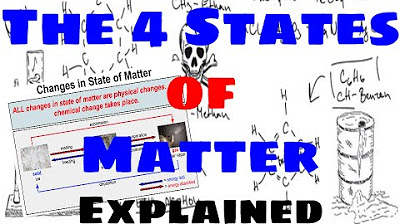Bagaimana Proses Terbentuknya Embun? #BelajardiRumah
Summary
TLDRThis educational video explores the fascinating process of condensation, a physical change where a substance transitions from a gas to a liquid state. It explains that this transformation is driven by the release or absorption of heat, with the environment's temperature playing a crucial role. The video uses everyday examples such as morning dew, which forms when water vapor cools and condenses into tiny water droplets, and the condensation on cold surfaces like car windows or a hot drink's lid. It also touches on the role of condensers in various applications, making the concept relatable and informative.
Takeaways
- 🌡️ Phase changes of matter are fundamental processes in our daily lives, involving transitions between solid, liquid, and gas states.
- 💧 Condensation is a phase change where a gas or vapor turns into a liquid, often due to the release of heat or a decrease in temperature.
- 🌬️ The process of condensation can be facilitated by factors such as cooling vapors intentionally, increasing pressure, or the presence of a condensation nucleus.
- 💧 The term 'condensate' refers to a liquid that has condensed from a gas or vapor, while a 'condenser' is a device used to facilitate the condensation of vapor into a liquid.
- 🔧 Condensers are typically made using cooling or heat exchange equipment, designed for specific purposes such as in refrigeration systems.
- 🌅 Morning dew is a common example of condensation, where water vapor in the air condenses into small water droplets on cool surfaces as the temperature drops during the night.
- 🌤️ Clouds forming and then turning into rain is another example of condensation, where water vapor in the atmosphere condenses into droplets large enough to fall as precipitation.
- 💦 Condensation can also cause surfaces like car windows or glasses to become foggy when the outside is cold or rainy, as the warmer, moist air inside condenses on the cooler surface.
- ☕️ The outer surface of a hot or warm drink can become damp due to the condensation of water vapor from the air, which then turns into tiny droplets on the cooler surface of the cup or glass.
- 🔔 Understanding the process of condensation is important for various applications, including weather phenomena, refrigeration, and industrial processes.
Q & A
What is the process of condensation?
-Condensation is the process where a substance changes from a gas or vapor to a liquid state, typically involving the release of heat.
What are the fundamental factors that cause condensation?
-Condensation occurs due to factors such as cooling of vapors intentionally, increasing pressure to turn them into a liquid, and the presence of a condensation nucleus.
What is the difference between a condensate and a condenser?
-A condensate is a liquid that has condensed from a gas or vapor, while a condenser is a device used to facilitate the condensation of vapor into a liquid.
Why does condensation often occur in the morning?
-Condensation often occurs in the morning because the temperature of the air drops during the night, causing the air to reach a dew point where water vapor condenses into droplets, forming dew or fog.
What is the dew point and how is it related to condensation?
-The dew point is the temperature at which air becomes saturated and can no longer hold all the water vapor it contains, leading to condensation.
How does the presence of a cold surface affect condensation?
-A cold surface can cause the temperature of the surrounding air to drop, reaching the dew point and leading to condensation on the surface, such as on windows or car exteriors.
What is the role of a refrigerant in the condensation process?
-A refrigerant is used in a condenser to absorb heat from the vapor, causing it to cool and condense into a liquid.
Can condensation occur without a change in temperature?
-Condensation typically requires a change in temperature or an increase in pressure to occur, as it involves the transition of a substance from a gaseous to a liquid state.
What is the significance of condensation in the water cycle?
-Condensation plays a crucial role in the water cycle by converting water vapor in the atmosphere into liquid droplets, which can then form clouds and eventually precipitate as rain.
How does condensation differ from other phase changes like evaporation or sublimation?
-Condensation is the process of a substance becoming a liquid from a gas, while evaporation is the process of a liquid turning into a gas, and sublimation is the direct transition from a solid to a gas without passing through the liquid phase.
Outlines

This section is available to paid users only. Please upgrade to access this part.
Upgrade NowMindmap

This section is available to paid users only. Please upgrade to access this part.
Upgrade NowKeywords

This section is available to paid users only. Please upgrade to access this part.
Upgrade NowHighlights

This section is available to paid users only. Please upgrade to access this part.
Upgrade NowTranscripts

This section is available to paid users only. Please upgrade to access this part.
Upgrade NowBrowse More Related Video

Changes of State | Matter | Physics | FuseSchool

CHANGES IN STATES OF MATTER || FREEZING, MELTING, CONDENSATION, EVAPORATION, SUBLIMATION, DEPOSITION

The Four States of Matter - Explained

Topnienie, krzepnięcie, parowanie, skraplanie #4 [ Zjawiska cieplne ]

Wujud Zat dan Perubahannya | IPAS Kelas 4 Kurikulum Merdeka

Matéria e energia [Módulo 01_Aula 01]
5.0 / 5 (0 votes)